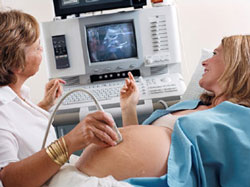Pregnancy Monitoring
1. Preconception Counseling
Preconception healthcare is the care a woman of childbearing age receives before pregnancy. This type of care monitors biomedic, behavioral, and social risk factors that could affect the health of the woman and the fetus. The goal is to provide information and treatment before pregnancy to improve the woman's health and help reduce risks to the fetus.

2. First Trimester Tests
- Complete Urine / Urine Culture
- Hemoleukogram and Blood Group
- Indirect Coombs Test
- Hemoglobin Electrophoresis
- Glycemia
- Thyroid Tests
- Liver Tests
- Kidney Tests
- Toxoplasmosis (IgG, IgM)
- Rubella (IgG, IgM)
- Cytomegalovirus (IgG, IgM)
- Tests for sexually transmitted diseases (syphilis, HIV-AIDS)
- Viral Hepatitis Tests (HBsAG, HVC)
- Ultrascreening (Bi-test + Nuchal Translucency + Nasal Bone)
3. First Trimester Obstetric Ultrasound
The first trimester obstetric ultrasound, among other things, examines: The position of the pregnancy (i.e., inside or outside the uterus), The number of embryos, The presence of heartbeats, Pregnancy age (from the first day of the menstrual cycle) etc.
4. Prenatal Screening for Fetal Anomalies
Every pregnancy has a probability of being affected by different fetal anomalies (chromosomal, genetic, etc.). Through screening programs, we aim to separate from the pregnant women population the group that carries the highest risk of being affected by a certain anomaly. These pregnant women with positive screening results are offered detailed information and the possibility of diagnosis through invasive prenatal diagnostic procedures. The stages of prenatal screening for fetal anomalies:
- Week 11 – 14: First trimester Ultrascreening (Nuchal Translucency + Nasal Bone + Bi-test)
- Week 15 – 18: Triple test
- Week 18 – 22: Morphological Ultrasound in the second trimester
5. Diagnosis of Fetal Anomalies
For prenatal diagnosis, examination of fetal tissues / cells is required. This can be achieved through invasive procedures under ultrasound guidance (Amniocentesis, Chorionic Villus Sampling, Cordocentesis) which must be performed by specially trained personnel.
6. Second Trimester Obstetric Ultrasound (Morphological Ultrasound weeks 18-22)
The morphological ultrasound is a standard also offered in Albania. Unfortunately, a part of the pregnant women are more compliant with determining the sex of the baby through ultrasound than with the morphological ultrasound. Besides detecting Down syndrome (the most common chromosomopathy), it can also diagnose other fetal malformations.
7. Second Trimester Tests (weeks 15 – 28)
The obstetrician will decide the frequency and order of the following tests/examinations:
- Triple test (week 15-18). The triple test is a good alternative for detecting fetal anomalies in pregnant women who have not benefited from biochemical screening (bi-test) in the first trimester. Women who test positive after the triple-test are offered invasive diagnosis (amniocentesis).
- Complete Urine / Urine Culture
- Hemoleukogram
- Possible repetition and/or IgM antibodies to the TORCH complex if corresponding IgG are negative.
- If age is > 36 years, amniocentesis is advised (week 16).
- Cervico-vaginal swab for various infections that may risk abortion
- Transvaginal Ultrasound for evaluating the length of the cervix
- Morphological Ultrasound (study of fetal anatomy and Doppler velocimetry in uterine arteries)
- Basic Glycemia
- Glucose Tolerance Test
8. 3-dimensional (3D) and 4-dimensional (4D) Fetal Ultrasound
3-dimensional (3D) and 4-dimensional (4D) ultrasounds have become increasingly popular and more available to patients. With 3D ultrasound, a series of 2D sections are digitally reconstructed to give as realistic a view as possible.
With 4D ultrasound, the added dimension is time, thus it appears as though the 3D images move in real-time. The 3D/4D images are typically displayed in golden color on the ultrasound screen, as this is a color that is easily distinguished by patients and emphasizes the baby's features. At the end of the examination, the couple is provided with a CD (against a symbolic fee) containing photos/videos of their baby. It should be noted that 3D/4D ultrasound is not an emergency ultrasound, and as such should always be scheduled.
9. Third Trimester Tests (weeks 28 – 41)
The obstetrician will decide the frequency and order of the following tests/examinations:
- Hemoleukogram
- Complete Urine / Urine Culture
- Obstetric Ultrasound (fetal biometry, Doppler velocimetry, amniotic fluid, placenta, fetal presentation)
- Liver Tests
- Kidney Tests
- Uricemia
- Non-Stress Test
- Coagulogram
- Vaginal / rectal swab for detection of infection with beta-hemolytic streptococcus
10. Third Trimester Obstetric Ultrasound
The third trimester obstetric ultrasound aims to evaluate fetal well-being (growth, amniotic fluid, Doppler velocimetry), study the placenta (echostructure, localization, etc.), fetal presentation. It also performs a fetal anatomical study (of course, not as detailed as the morphological ultrasound).
11. NST (Non-Stress Test)
The Non-Stress Test is a simple, non-invasive test performed in pregnancies over 28 weeks. The test is called "non-stress" because no stress is applied to the fetus during it. The test is done by placing a belt on the mother's abdomen to measure the fetus's heart rate and another belt to measure the uterus's contractions. The movement, heartbeats, and "response" of the heartbeats to movement or contractions are measured for 20-30 minutes. A reactive result in NST indicates that blood circulation (and oxygenation) in the fetus is sufficient. A non-reactive result should be interpreted in context with other examinations and can assist in decision-making by the obstetrician.
Very beautiful material and accurate
Sent by suzana, më 09 February 2015 në 02:52